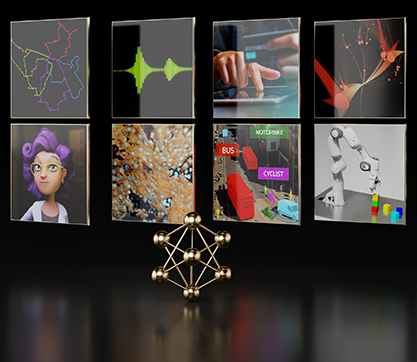
RAXX P1G with NVIDIA L40S GPUs Part II: Use Cases
As we covered in the first blog in this series, the AI, graphics, and media acceleration capabilities of the NVIDIA L40S GPUs (up to four) inside the rack mounted RAXX P1G workstation module make it an ideal platform for both AI and media & entertainment (M&E) workloads. Now, let’s look at some sample use cases.
With outstanding inferencing capabilities, NVIDIA RTX™-accelerated raytracing, and dedicated encode and decode engines, the L40S GPUs inside the RAXX P1G accelerate AI-enabled audio, speech, 2D, video, and 3D generative AI applications. For image generative AI inference, the new GPUs provide over 5X higher performance than the previous gen NVIDIA A40 GPU and 1.2X more performance than the NVIDIA HGX A100.
LLM Inference and Training
The unmatched throughput and floating-point performance of the RAXX P1G’s NVIDIA L40S GPUs accelerate training, fine tuning, and inference workloads to build and deploy AI models. When you combine the compute capabilities of the L40S GPU with NVIDIA’s inference serving software the result is a powerful platform for trained models ready for inference. Support for structural sparsity and a variety of precisions (TF32, INT8, and FP8, for example) provide over 1 petaFLOPS of inference operation performance for fast and precise actionable insights.
NVIDIA AI Enterprise software
Although NVIDIA AI Enterprise is not an actual component of the NVIDIA L40S GPU, it still requires mention. It’s actually an enterprise grade AI software platform with over 100 frameworks, pretrained models, and libraries designed to streamline development and deployment of production AI like generative AI, computer vision, and speech AI.
When paired with NVIDIA L40S GPUs, NVIDIA AI Enterprise can develop applications once, deploy them anywhere, and thereby reduce the risks involved with moving from pilot phase to production.
If you’re interested in the RAXX P1G to support your M&E workflow with applications like DaVinci Resolve, Cinema 4D, Autodesk Maya, V-Ray, and Octane Render (to name but a few), the inclusion of up to four NVIDIA L40S GPUs is also a game changer. Read on.
Rendering and 3D Graphics
By upgrading to the NVIDIA L40S GPU, the RAXX P1G will allow for more iterations and accelerated rendering, so artists can complete projects on time, increase productivity, and ultimately increase profit. If you recall from the previous blog, the GPU’s third gen RT Cores and 48GB of GDDR6 memory provide up to 2X the real-time raytracing performance of the previous gen, so VFX artists, animators, and designers can work with complex geometry and high-res textures in real time, generating photorealistic designs or powering interactive rendering and virtual production.
Streaming and Video
With three video encode engines, three video decode engines, and the addition of AV1 encoding, the new NVIDIA GPUs dramatically accelerate streaming and video workflows, providing up to 2X the performance and improved total cost of ownership (TCO) for broadcast streaming, video production, and transcription workloads.
Conclusion
Last but not least, if your organization utilizes RAXX P1G as the engine of NVIDIA Omniverse in your data center, the NVIDIA L40S GPUs can power extended reality (XR) workloads like design collaboration and digital twins, along with accelerating rendering, simulation, and photorealistic 3D in even the most complex Omniverse workflows.
The RAXX P1G is ideal for large scale AI or M&E deployment and (in addition to the GPU upgrade) is powered by a single AMD EPYC™ 7003 processor (up to 64 cores). The 1U rack-mounted system also features advanced air cooling, 2TB of memory, and rear I/O access to two 1 GbE LAN ports, one IPMI port, and two USB 3.0 ports. To configure yours, contact a BOXX performance specialist via chat or at 877.877.BOXX.



